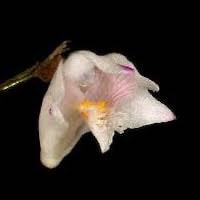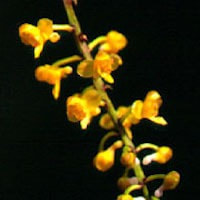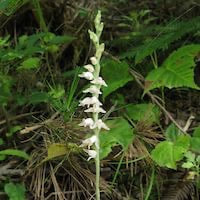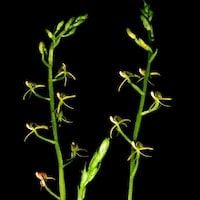MFL2- Men's Floral 2, - Vanilla affair
|
Native Singaporean Orchid notes: Brassavola Martiana
Brassavola Martiana, or Von Martin's Brassavola, contributes to the fragrance Floral 2 (Men) for Team building Perfume workshops. Named after Von Martin, a German orchid collector, it emits a sweet, soapy scent resembling a fresh shower. Unlike its hybrid Brassavola Singapura, which is harder to grow, Brassavola Martiana is preferred for its easier cultivation and similar aromatic profile. Its refreshing fragrance enhances the perfume's appeal in team-building activities.
|
Therapeutic Orchid notes:
|
Dendrobium planibulbe Lindl.
Dendrobium planibulbe Lindl. is a unique orchid known for its flowering behavior triggered by temperature drops. This characteristic adds to its allure. In traditional Peninsular Malaysian herbal medicine, it's used to treat sores and wounds. The orchid is crushed into a poultice applied externally for its medicinal properties believed to aid healing and fight infections. Overall, it's valued both for its flowering habits and medicinal uses in local practices. |
|
Robiquetia succisa (Lindl.) Seidenf. and Garay
Robiquetia succisa (Lindl.) Seidenf. and Garay, known as Jishu lan in Chinese, preci-pice orchid or big ladder orchid in Hong Kong, and Uang Man Pu in Thai, blooms from May to August in Thailand and northeast India, and from June to September in China. Found in open forests and cliffs from India to China, it contains small amounts of alkaloids. In Chinese Traditional Medicine, it's used to soothe "heaty coughs" and lungs, acting as a blood tonic. |
|
Goodyera schlectendaliana Rchb. f.
Goodyera schlectendaliana Rchb. f., known as Dabanye Lan (Large speckled orchid), Jinbian Lian (Gold border lotus), Yinherhuan (Silver ear orchid), Yinzong Lian (Silver palm lotus), and Mountain jewel orchid in Chinese, Da Wu Shan Ban Ye Lan (Mountain dawn etched/speckled orchid) and Gao Shan Lian (Mountain lotus) in Taiwanese, and Miyama uzura (Quail of the deep mountain) in Japanese, is a dwarf orchid native to China, Japan, and Southeast Asia. It contains a unique flavonol glucoside called Goodyerin, known for its sedative and anti-convulsant properties. In Traditional Chinese Medicine, the plant is used to treat respiratory issues, pain, tuberculosis, asthma, and weak kidneys, and is applied topically for pain relief and consumed as a tonic for internal injuries. |
|
Liparis bootanensis Griff. Syn. Liparis plicata Franch & Savat.
Liparis bootanensis Griff., also known as Liparis plicata Franch & Savat., is called Lianchiyangersuan (sickle wing goat ear garlic) in Chinese, Twayblade in Hong Kong and Bhutan, Jiuliandeng (nine lotus lamps) in Chinese medicine, single leaf Liparis in Taiwan, and Chi-kei-ran (bamboo grass Cymbidium) in Japanese. This herb grows epiphytically or lithophytically, with small clustered pseudobulbs. It thrives across Nepal to southern China, including areas like Taiwan and Japan, at elevations of 800 to 2300 meters. In Traditional Chinese Medicine, the entire plant is used to treat fever, tuberculosis, sores, ulcers, and various other ailments. |
Other scent note
Scentopia Library Reference ingredient
Violet - Check details at Scentopia's scent library
Download the guided mediation that works best with this Orchid fragrance oil
| men_floral_essential_oil_orchi_00002.mp3 | |
| File Size: | 133671 kb |
| File Type: | mp3 |




